These savory vegan collard greens cook in less than 30 minutes and taste great without the meat! Whether you’re looking for southern collard greens or soul food style collard greens, this easy recipe will help you make a pot of greens your friends and family will love.
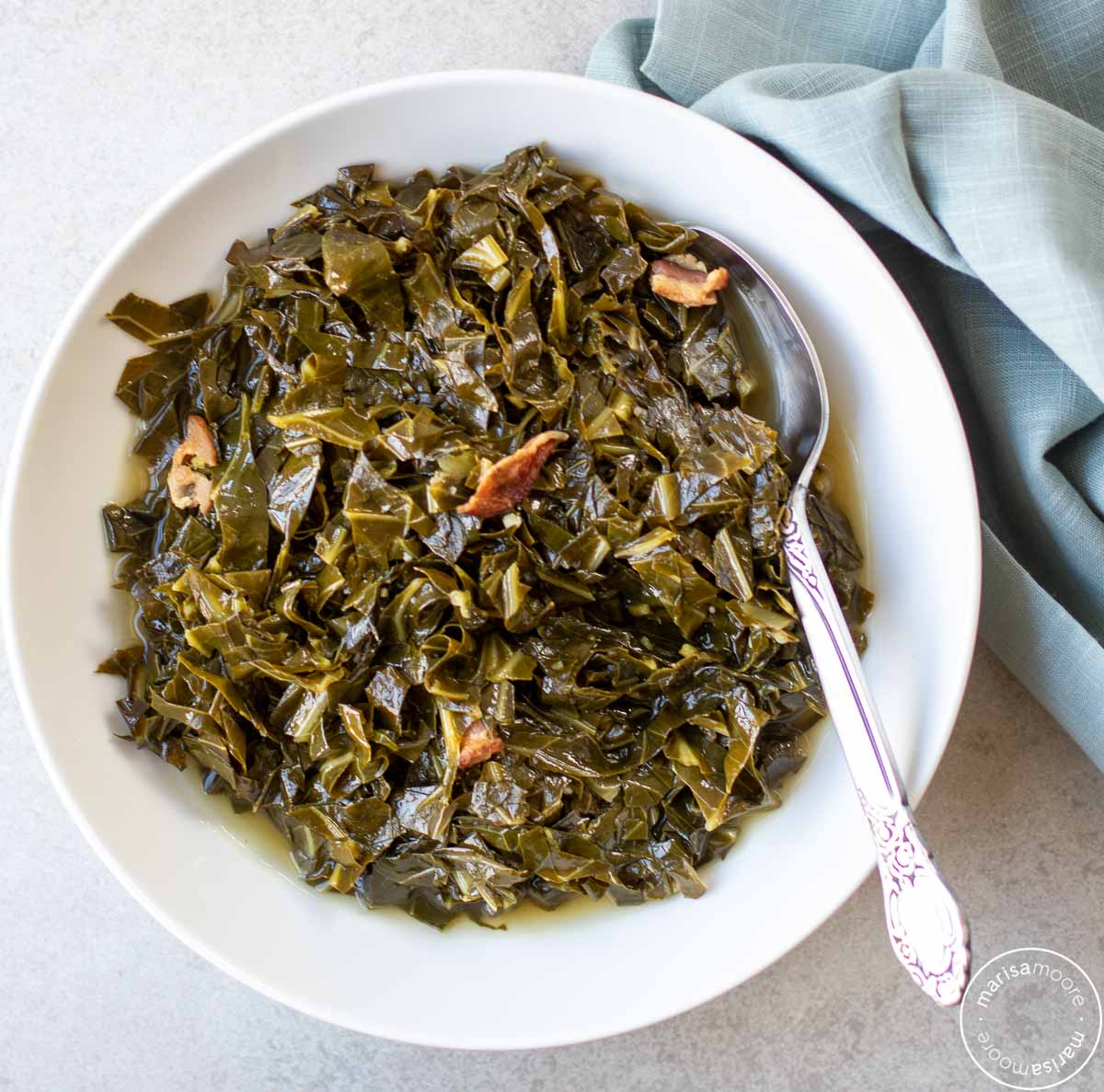
Few recipes bring as much joy as a pot of greens on the stove in the winter. Collard greens are also a holiday staple. And this vegan version cooks up quick.
Though cleaning and cutting collard greens can take some time, once they are prepped, cooking is easy and can be a lot faster than you think. Serve these greens with cornbread, on a veggie plate or as a side dish for Sunday dinner.
Greens without the meat
Yes. You can make vegetarian or vegan collard greens that taste just as good as traditional soul food greens!
The key is using a savory, rich broth. And onion, garlic and red pepper flakes are a few of my favorites to add to the mix.
For smoky flavor, you can add smoked paprika or a pinch of smoked salt. (Many people use liquid smoke but I don’t personally use it in my cooking.)
Ham hocks or fat back are traditionally used to make authentic southern collard greens. More recently people use smoked turkey legs or necks to add savory flavor. My family uses ham hocks. And that’s what I eat when I go home to the Carolinas.
But I love this vegan recipe for regular Sundays and weeknight meals at home. It’s quick, flavorful and very easy to make – once you get your greens prepped. Plus, they are good for you too.
Nutrition benefits
Collards are one of the healthiest greens. Collard greens have calcium, fiber, and plenty of phytonutrients making them a healthy pick.
As a registered dietitian nutritionist, I love that I grew up eating and loving these nutritious greens (plus turnip and mustard greens) as a child. But had no idea how good they are for us.
Collards are a member of the brassica family. This cruciferous vegetable has similar benefits to cabbage, kale, broccoli, and Brussels sprouts.
Collard greens are versatile. You can braise them – drinking the potlikker to get all of the nutrients. Or blanch them to use as a wrap for sandwiches, toss them into soups or even saute for a side dish.
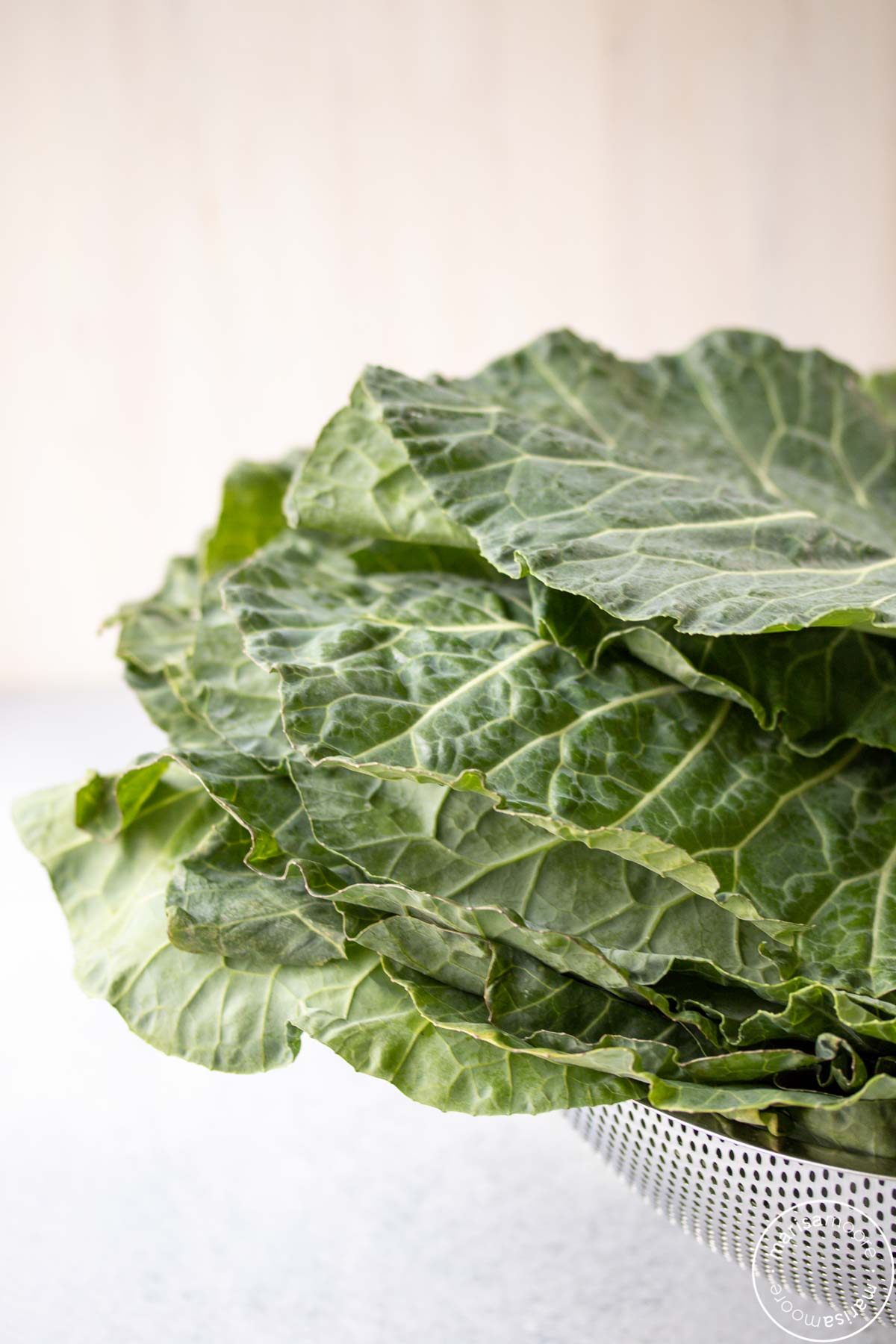
How to pick the best collard greens
Collard greens are in season during the cooler months and taste best in December and January. So, now is the perfect time to grab a bunch of these healthy winter greens.
Start with the freshest greens you can find.
Look for collard greens that are a dark green color with no yellowing leaves. The leaves should feel supple and firm not limp or dry. Collards are a hardy green and will last for a while as long as they are stored without excess moisture trapped in the leaves.
I grew up with my Grandma getting huge heads of collard greens with big mature leaves. Nowadays, I buy small bunches of young collard greens. They are easier to handle, easier to clean and I think they take a little less time to cook.
Buying fresh collard greens
Consider buying your greens directly from the farm or at the farmer’s market for the freshest start. They are inexpensive at about $2 per bunch in the supermarket or if you’re local to Atlanta, even cheaper at the Dekalb Farmer’s Market.
You’ll pay more at some of the community farmer’s markets here but I support when possible.
I don’t recommend buying pre-cut bagged collard greens. They are often tough and full of stems. Plus, the greens are usually torn into big pieces that I don’t personally enjoy.
If you are adding bagged greens to a soup or stew… it might work. But I’d skip it for a pot of braised greens.
Canned collard greens? I am also not a fan of canned greens. But frozen chopped collard greens are OK for a soup or stew. The recipe below uses fresh, whole collard greens. It’s not a fast process but it’s worth it.

How I clean my greens
Cleaning collard greens takes time. And there are two main methods:
Method One
Separate the bunch of collard greens into individual leaves.
Rinse each leaf carefully under cool running water. Take care to rub away any soil or debris that might collect around the stem. Be sure to rinse both the front and backside of the leaf. Once clean, stack the leaves and prepare to slice.
Method Two
Instead of using running water, swish and soak the greens in several changes of a large bowl of cool water. The dirt will settle to the bottom of the bowl. You’ll know the greens are clean when the water is clear.
Whether you wash or cut your greens first, the key is to be really picky. Because of the way they grow, collard greens are notoriously difficult to clean. If you don’t do it right, your greens will be gritty.
So. Put on some music and take the time to clean your greens. Lots of time.
If it didn’t take so long to prep them, I might eat collard greens every day.
Prep ahead: I tend to clean more than one bunch of collards at a time. The cut, sliced greens will keep for a week or longer in the fridge.
Just be sure to remove all excess moisture and store them an airtight bag or container in the refrigerator. This works very well if you’re prepping ahead for the holidays or special occasions.
Best way to store greens
Fresh, unwashed collard greens will last about one week uncooked in the refrigerator. The key is making sure the greens are dry. So wash them right before you’re ready to cook them.
You can also prepare the greens this way. Wash, cut, and spin the greens dry. Store in a plastic bag with a paper towel to absorb any lingering water.
Once the greens are cooked, eat them within 1-2 days.
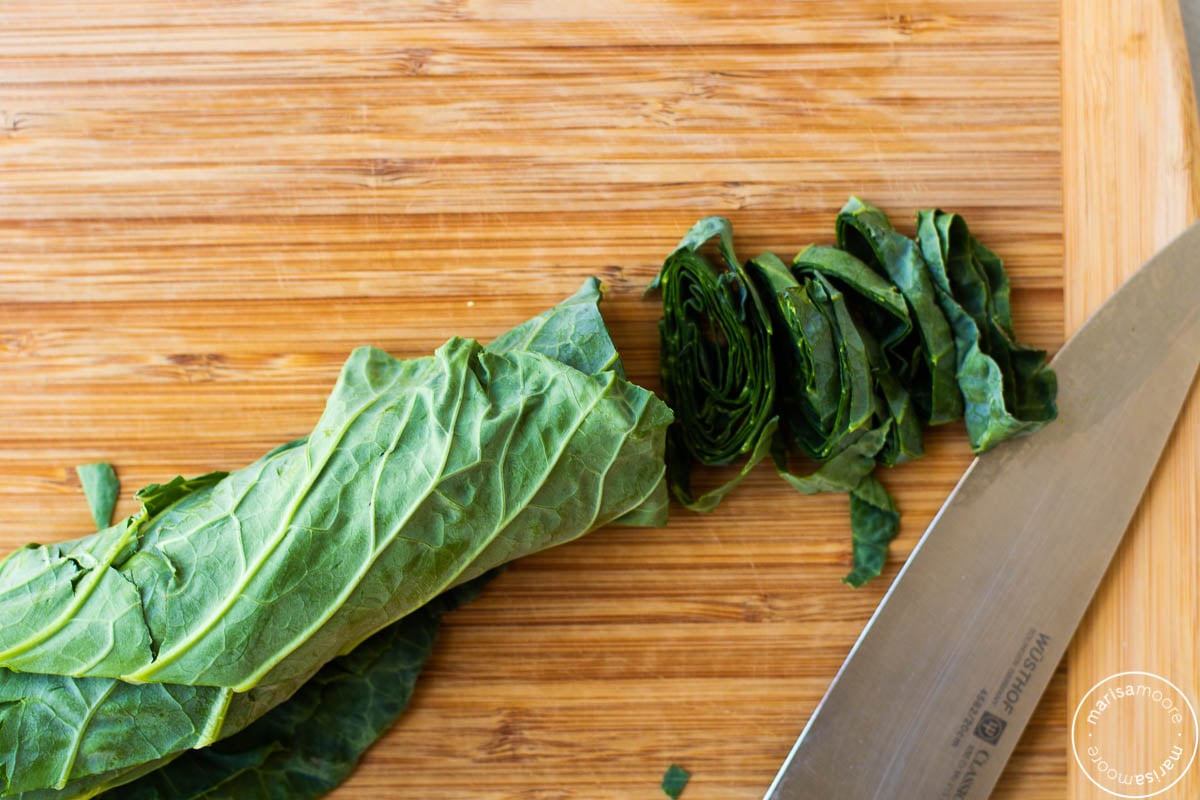
Prepping collard greens to cook
Learning how to cut collard greens is a rite of passage in Black families. My family prefers thinly sliced greens. My Grandma cut her greens into super thin and so do I. In cooking terms it would be called a chiffonade or julienne.
Whether you go for big flat ribbons or more of a shred, just make sure they are even. For uniform cooking, slice your greens into evenly sized pieces. For this recipe, I went with a thin slice which helps reduce cooking time.
Can you eat collard stems?
Yes. But you need to cut them up small and about the same size. Cooking the stems for a long time will help them to become tender. And even still, I highly recommend removing the toughest part of the stem – the woody part near the bottom.
I usually cut most of the stem out as a personal preference and for uniformity and ease of cooking.
Making tender collard greens
The secret to tender collard greens is moisture, fat and time.
Braised collard greens are a southern staple. Braising (cooking with liquid in a covered pot) allows for the greens to cook until they are silky and tender. It’s the most common method. Traditional greens are cooked down with meat (usually a ham hock), low and slow.
You’ll also want to include some fat. I like using olive oil. It helps tenderize the tough greens but also helps your body absorb more nutrients from the greens. So once again, fat is good.
Ingredients
To make these vegan collard greens, you’ll need only a few ingredients. Here’s your grocery list:
Fresh collard greens bunch
Onion
Garlic
Broth or stock
Sugar (optional but helps with any bitterness)
Red pepper flakes or fresh hot peppers
Apple cider vinegar, for serving
Note: You can add bits of tempeh or textured vegetable protein to the pot if you miss the small pieces of meat common in greens.

Add vinegar
Though some swear by hot sauce or chow chow, adding a cap full of vinegar is essential in my family. From the youngest kids to the elders, everybody grabs the bottle right before eating.
A splash of vinegar brightens up the dish without being overpowering.
My Easy Honey Cider Collard Greens uses apple cider vinegar with honey for a sweet, tart balance that just works. Braising collards with cider and honey makes them soft and perfectly balanced with sweet and savory. A comfort food favorite!
Below I’m sharing my easy vegetarian recipe.
What to serve with collard greens
Cornbread. I can honestly eat cornbread and greens and call it dinner. It’s the perfect side for the flavor and contrast in textures.
You can also serve collard greens with vegan Black-Eyed Peas, fried fish or chicken, or on a southern-style veggie plate paired up with a variety of your favorite sides.
Cornbread is essential really. But these corn fritters without the cheese work too.

Vegan Collard Greens
Ingredients
- 2 tablespoons olive, avocado oil (or any neutral-tasting oil)
- ¼ teaspoon red pepper flakes
- 2 cloves garlic, minced
- 8 cups sliced collard greens (cut into small ribbons, see picture)
- 1- 1½ cups vegetable broth
- pinch of sugar (optional)
Instructions
- Heat the oil over medium-high heat. Add red pepper flakes to the oil. Cook for about 1 minute, until fragrant. Add the garlic and cook for about 1 minute or just until fragrant.
- Add the sliced greens to the pan and salt. Turn the greens to coat in the oil. Add 1 cup broth (you may need to add more at the halfway point) and a pinch of sugar if using.
- Cover. Cook 25-30 minutes (sliced small, as shown in the picture) on low heat, or until desired tenderness adding more broth as needed to keep the pot from drying out.

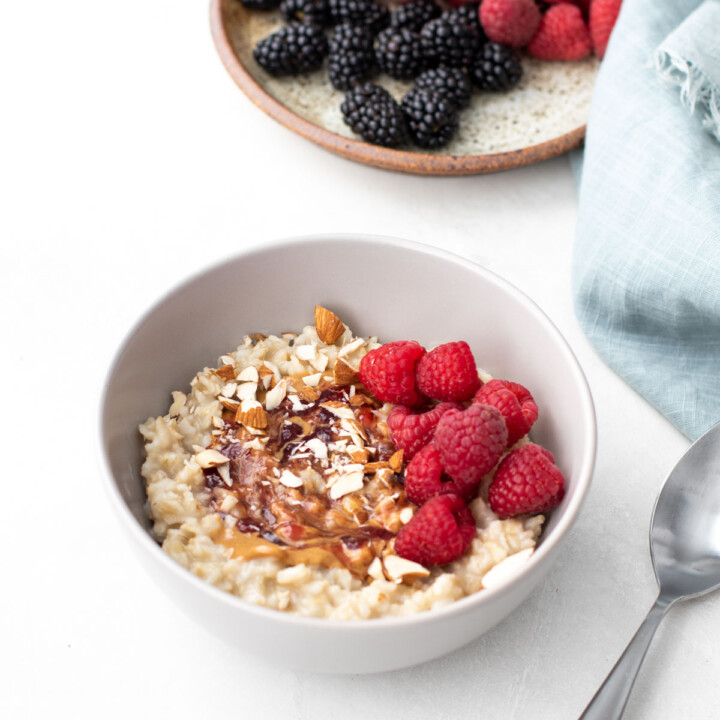

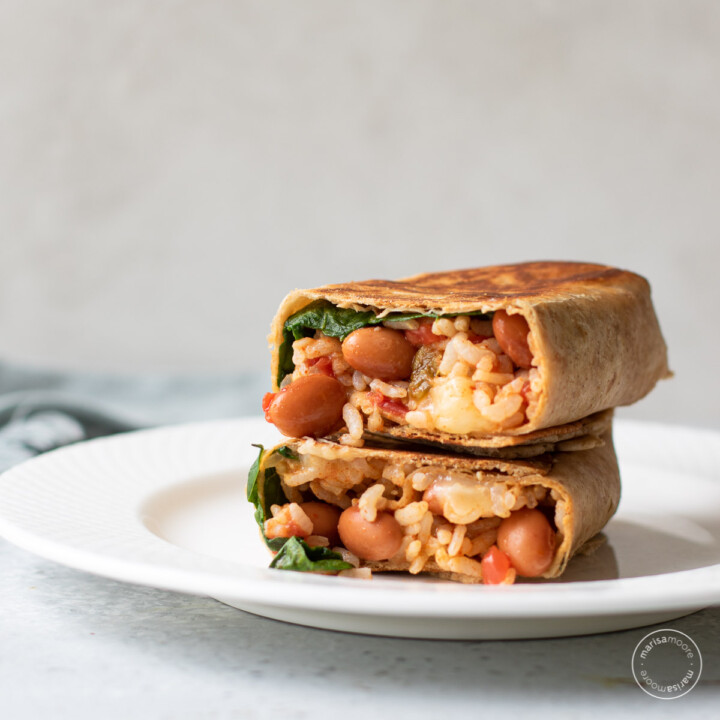
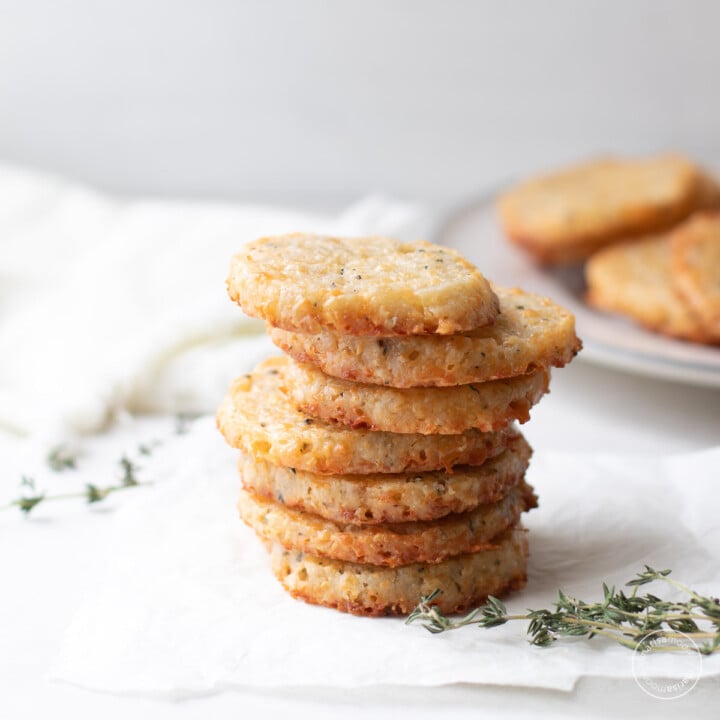

Leave a Reply